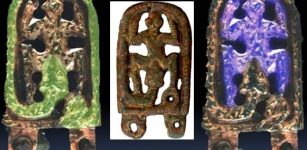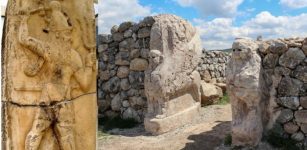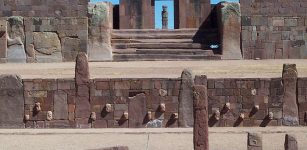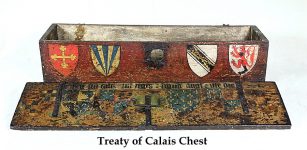“Thogcha” – Thousand-Year-Old Tibetan Amulets And The Bon Culture
A. Sutherland - AncientPages.com - Enigmatic small amulets known as' thokchas' (thogchags) are made of iron, meteoric iron, or, as Tibetans say, "sky metal" or "sky-iron" denote tektites and meteorites, which are often high in iron content.
Tibetan thokcha, showing crouching lion in centre. Credit: Clemensmarabu - CC BY-SA 3.0
"Thogcha," heavenly iron or sky iron, has been used by Tibetans for thousands of years to create small talismans with a strong connection to the sky. Their tradition is much older than the Buddhistic tradition in Tibet and has its beginning in the pre-Buddhist period of Tibet.
Historically, thokchas were highly respected objects and used for sacred metallurgical fabrication of weapons, musical instruments, and sacred (religious) tools, like - the phurba, a three-sided peg, stake, knife, or nail-like ritual implement traditionally associated with Indo-Tibetan Buddhism, Bon (Bön), a Tibetan religion and Indian Vedic traditions.
The use of 'thogcha' in the metallurgical fabrication of sacred objects cast of Panchaloha is well-documented. The term has also denoted ancient metal objects as amulets made from thokcha. They are traditionally endowed with magic and protective power and are comparable to Tibetan Dzi beads.
Tibetan thokcha in the shape of a small arch. It may originally have been a tool used to open knots in leather straps that secured pack animal loads. Credit: Clemensmarabu - CC BY-SA 3.0
It was when the so-called Bon religion and culture with its heavenly origin dominated.
Even today, many rituals to attract luck and good fortune and chase away evil forces are conducted regularly because the power of tradition and human beliefs has always prevailed.
Bon's indigenous religion and culture were long-time dominant religious forces in the plateau. Though considerably transformed by Buddism, the Bon has survived and is still preserved among Tibetan communities living in exile.
Many ancient Tibetan scriptures supported by archeological evidence refer to the Bon culture and its roots spanning 18,000 years.
As John V. Bellezza, an explorer, a writer, and the foremost archaeology specialist in the cultural history of Tibet said that there is "... a close association with indigenous Tibetan religious beliefs and their practitioners and form a very important part of the country's pre-Buddhist and Buddhist heritage. For instance, the frequency of animal designs recalls the sacred status of animals in Tibetan culture..."
 Meteorite DZI bead "9 eyes" carved from Aletai iron meteorite. Image credit: IPlantagenet - CC BY-SA 4.0
Meteorite DZI bead "9 eyes" carved from Aletai iron meteorite. Image credit: IPlantagenet - CC BY-SA 4.0
Believed to be magically formed, powerful thogchags belong to the most treasured possessions of the Tibetans. As they say, if you own one, you are happy, but the Gods bless you if you own nine of them!
They are most often worn around the neck on a blessed cord. Sometimes they used to be attached to a mala used for spiritual practice, a prayer wheel, or objects frequently used by Tibetan magicians, healers, and shamans, in rituals performed by them.
Sacred "thogchags" represent a variety of shapes and forms, from simple depictions of animals, and tiers symbolizing the five elements (space, air, fire, water, and earth). These elements compose the universe
The most ancient depictions on the small miniatures are beyond the comprehension of modern-day Tibetans, who do not understand their true meaning. In this way, they remain the concealed mystery of the ancients.
Priceless "thogchags" are considered to have great medicinal value and almost supernatural quality. Due to their mystical healing properties, they are true treasures. Families in Tibet pass down these sky relics from one generation to another.
No one has ever questioned their value and importance.
Written by – A. Sutherland - AncientPages.com Senior Staff Writer
Updated on August 18, 2022
Copyright © AncientPages.com All rights reserved. This material may not be published, broadcast, rewritten or redistributed in whole or part without the express written permission of AncientPages.com
More From Ancient Pages
-
 Unique Medieval Bronze Buckle Of A Snake Devouring A Frog-Like Creature Found In Brno, Czech Republic
Archaeology | Dec 13, 2023
Unique Medieval Bronze Buckle Of A Snake Devouring A Frog-Like Creature Found In Brno, Czech Republic
Archaeology | Dec 13, 2023 -
 Archaeologists Encounter A 1,500-Year-Old Mystery In Kent, UK
Archaeology | Mar 16, 2022
Archaeologists Encounter A 1,500-Year-Old Mystery In Kent, UK
Archaeology | Mar 16, 2022 -
 ‘Bone Biographies’ Reveal Lives Of Medieval England’s Common People And Illuminate Early Benefits System
Archaeology | Dec 6, 2023
‘Bone Biographies’ Reveal Lives Of Medieval England’s Common People And Illuminate Early Benefits System
Archaeology | Dec 6, 2023 -
 La Garma Cave Offers Evidence Of Over 300,000 Years Of Human Activity
Featured Stories | Dec 5, 2023
La Garma Cave Offers Evidence Of Over 300,000 Years Of Human Activity
Featured Stories | Dec 5, 2023 -
 Unique Discovery – 2,000-Year-Old Roman Coins Found On Gotska Sandön In Sweden
Archaeology | Apr 13, 2023
Unique Discovery – 2,000-Year-Old Roman Coins Found On Gotska Sandön In Sweden
Archaeology | Apr 13, 2023 -
 Neanderthal Genes Influence Your Mood And Much More – Study Shows
Archaeology | Oct 6, 2017
Neanderthal Genes Influence Your Mood And Much More – Study Shows
Archaeology | Oct 6, 2017 -
 Mysterious Ancient Underground King And Ruler Of The World – Who Was He? Part 1
Ancient Mysteries | Jul 25, 2018
Mysterious Ancient Underground King And Ruler Of The World – Who Was He? Part 1
Ancient Mysteries | Jul 25, 2018 -
 Ancient Site Tres Zapotes Offers Evidence The Olmecs Practiced Shared Governance
Archaeology | May 30, 2017
Ancient Site Tres Zapotes Offers Evidence The Olmecs Practiced Shared Governance
Archaeology | May 30, 2017 -
 Egyptians Mastered Medicine Thousands Of Years Ago
Civilizations | Oct 1, 2015
Egyptians Mastered Medicine Thousands Of Years Ago
Civilizations | Oct 1, 2015 -
 Mystery Of The Delphi Oracle Prophecies: Was Pythia On Drugs While Guiding Ancient Greek Civilization For Thousands Of Years?
Civilizations | Nov 3, 2016
Mystery Of The Delphi Oracle Prophecies: Was Pythia On Drugs While Guiding Ancient Greek Civilization For Thousands Of Years?
Civilizations | Nov 3, 2016 -
 Code Of Nesilim: Ancient Laws Of The Hittites
Ancient History Facts | Jun 14, 2018
Code Of Nesilim: Ancient Laws Of The Hittites
Ancient History Facts | Jun 14, 2018 -
 How Henry VIII Accidentally Changed The Way We Write History
Featured Stories | Sep 6, 2024
How Henry VIII Accidentally Changed The Way We Write History
Featured Stories | Sep 6, 2024 -
 Superfood Of Ancient Andeans Reconstructed – What Helped To Fuel The Tiwanaku Civilization 2,500 Years?
Archaeology | Nov 30, 2021
Superfood Of Ancient Andeans Reconstructed – What Helped To Fuel The Tiwanaku Civilization 2,500 Years?
Archaeology | Nov 30, 2021 -
 Thousand Unearted Artifacts Reveal ‘Major’ Ancient Migration To Timor Island
Archaeology | May 23, 2024
Thousand Unearted Artifacts Reveal ‘Major’ Ancient Migration To Timor Island
Archaeology | May 23, 2024 -
 Wars Of The Roses: Thirty Two Years Of Struggle To Claim English Throne
Featured Stories | Aug 5, 2017
Wars Of The Roses: Thirty Two Years Of Struggle To Claim English Throne
Featured Stories | Aug 5, 2017 -
 On This Day In History: Robert I, King Of Scots Known As ‘Robert The Bruce’ Was Born – On July 11, 1274
News | Jul 11, 2016
On This Day In History: Robert I, King Of Scots Known As ‘Robert The Bruce’ Was Born – On July 11, 1274
News | Jul 11, 2016 -
 On This Day In History: Treaty of Calais Ratified Between France And England – On Oct 24, 1360
News | Oct 24, 2016
On This Day In History: Treaty of Calais Ratified Between France And England – On Oct 24, 1360
News | Oct 24, 2016 -
 Mysterious Ancient Remains Of The Lady In The Well – An Archaeological Detective Story
Archaeology | Sep 11, 2020
Mysterious Ancient Remains Of The Lady In The Well – An Archaeological Detective Story
Archaeology | Sep 11, 2020 -
 Enigmatic Figure Dated Back To 40,000 From Prehistoric Stadel Cave, Germany
Ancient Traditions And Customs | Sep 7, 2018
Enigmatic Figure Dated Back To 40,000 From Prehistoric Stadel Cave, Germany
Ancient Traditions And Customs | Sep 7, 2018 -
 Edøy Discovery: Traces Of 1,000-Year-Old Ship Burial Detected In Norway
Archaeology | Nov 24, 2019
Edøy Discovery: Traces Of 1,000-Year-Old Ship Burial Detected In Norway
Archaeology | Nov 24, 2019


